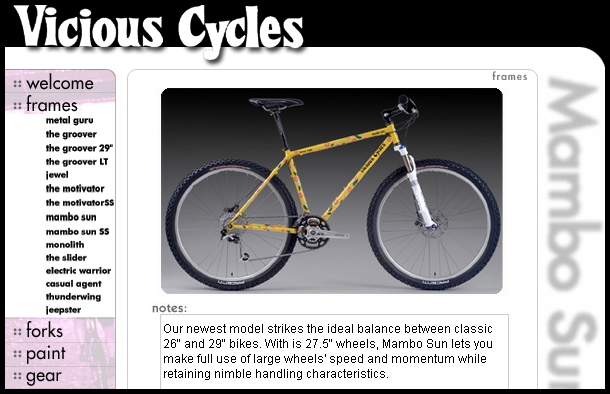I’m writing this the night before anyone will read it, and I’m pretty sure I’ve eaten some bad tuna. If this ends up being my last post, somebody avenge my death by punching Jarrod from Subway in the throat.
At any rate, I’m even woozier than usual, so tough to say just how Salvador Dali this is going to get. I read with great interest that 650b explosion post on Bikerumor. Actually it was only passing interest, given the wooziness. OK, actually, I didn’t even really read it all that well, but I did look at the pictures.
Alright, I didn’t even really look at every single one of the pictures. I did, however, happen to notice the absence of one Carl Schlemowitz in the discussion.
Carl Schlemowitz, in case you don’t know, is the guy who made me my first 29er and the first framebuilder I’d ever seen to show a genuine 650b mountain bike. Yes, Kirk Pacenti deserves a lot of credit for pushing 650b when no one else was, but really no early 650b bike looked at all like the one-off race bike Nino Schurter’s been using to win races. They were adventure touring bikes, and–other than Carl’s Mambo Sun–650b was basically synonymous with the look epitomized by Rawland bikes. The Vicious Cycles Mambo Sun was the first 650b bike to look anything like the ones making all the noise today.
I don’t mention this to pick any fights or play “I saw it first.” All this shit’s been done many years ago anyway. I mention Carl because if you do look at the arguments in favor of 650b right now, you’ll find a few distinct patterns. I summed them up in a post last February:
- There Was Never a Good Reason for 26″ Wheels in the First Place – One of the most important things 29ers did was dispel the myth of the 26″ wheel, which might as well have been chosen arbitrarily. When it comes to the preeminence of 26″ wheels in the world of mountain bikes, once the flood gates of doubt opened up, it became pretty which wheel size couldn’t swim. The 29er could never replace a 26″ wheel, but a 27.5″ wheel just might. And probably should. Get over it Europe. The 26″ wheel is stupid for anyone over five feet tall. That’s 152.4 centimeters.
- Nobody Wants to Look Stupid After Missing that 29er Thing – Once we hit that tipping point, adoption is going to happen with the quickness here. Not only did some companies look stupid for panning 29ers up until they finally caved in and released one (which then shot to the top of their sales charts and stayed there), but some companies made much more money by betting on the right horse. Money equals motion. Everybody wants to cover this next move, when it comes.
- Forks and Rims Are Already Here – The real teeth-pulling with 29ers happened around the rim, tire and fork manufacturers, but for 650b, that part of the puzzle’s already in place. It’s also a manufacturing reality that you just have to make different sizes now. All this shit is being mass-produced in China anyway, so you really can’t bitch about your overwhelming productions costs to Americans who pay more for a cup of coffee than it costs to have a tire made in China. You’re making two sizes of tires and rims already. Might as well just make another one.
- 650b Bikes Won’t Suck – By definition, they were designed to be the middle of the road, and, unless you’re a GOP candidate, that’s never a particularly dangerous place to be. Something like a 36″ tire will be pretty unlikely to be adopted by everyone, but a bike that rolls a bit better than a bike with 26″ wheels, but in all other ways feels about the same but has marketing buzz? That’s not a hard bike to sell. A 29er was a big difference, but the only people still riding 26″ wheels wouldn’t even know the difference if you put 27.5″ wheels on their bike.
- The Industry Needs This – Not just because new trends have to constantly drive you to want a new bike, but due to some very concrete reasons, there is a very powerful lobby going on for the middle wheel size right now. This is led largely by companies with skin in the five to seven inch travel frame game. You just can’t get enough distance between stuff to have a “longer travel” 29er. Something’s got to give. A system is already in place at most manufacturers to make that something a 650b long-travel suspension frame.
If you read the Bikerumor panel discussion of 650b bikes, this is basically what everyone is confirming, albeit with some extra dancing around and justifications.
But nobody contacted Carl at Vicious to ask his opinions about 650b–or maybe they did and Carl did the whole, “You kids get off my goddamn lawn!” bit. He’d have earned the right, but that’s not really his style. If anyone had asked, I think Carl would have told them he’d built a 27.5″ wheel bike for himself (he loathed the term “650b”) and rode it, and thought it felt pretty good, and that was why he made them. He’d also probably tell them that a small framebuilder has to be on the cutting edge of even the smallest trend, because that’s where any money is for small builders. That’s what I think Carl from Vicious would say, the guy who had a genuine 650b, er, 27.5″ mountain bike at Interbike in 2007.
My point in all this tuna-induced rambling is this: 650b showed up for the same nearly random reasons the arbitrary 26″ wheel showed up. It just sort of worked out that way, and there were enough spare parts around in that size to cobble stuff together. The idea has inertia behind it now, so market forces have locked on and it’s clear we’ll have some form of 650b bike all over the place next year. And why the hell not? They seem perfectly fine.
None of this, however, has anything to do with addressing the shortcomings of 29ers.
Let me explain, and then I’m going to go puke. The common complaint with designing a longer travel frame on a 29er is that the wheels are too large to move through much more than 130mm of travel without hitting into things like the seat tube.
The idea that smaller wheel is the only solution to that is absurd.
Does a 29″ wheel hit into your saddle at 140mm of travel? No? So your ass can stay put. What a 29er wheel hits is the seat tube and seatpost, and the rockers and rear triangle get awfully convoluted snaking around everything to make it all work, too. That’s a bitch. I’ve dealt with the clearance issues, and it really and truly is.
But so what.
Why not design a completely different seat post that’s out of the way. Road frames are doing this already with their “integrated posts” and they hardly even have a reason, so it can be done. Developing a proprietary seatpost is a hell of lot easier than inventing a new wheel size. Doing away with the conventional seat tube and post might seem crazy, but any more crazy than inventing a new wheel size? Besides, Shimano and SRAM have derailleurs that’ll bolt anywhere these days. Where we’re going, we don’t need seat tubes.
And the “wheels are too large in diameter to be strong enough” argument? Right. No one has ever made anything larger than 27.5″ in diameter that was also strong. Do you think materials advancements are making things weaker or stronger these days? I have to call bullshit on the weak wheel argument. Again, I’m fine with saying we want 650b just ’cause we want it, but don’t let’s pretend it’s the only solution.
I like 650b. I really do. I want to design a bitchin’ 650b bike, because I think they make more sense than 26″ wheel bikes. But I do believe sometimes the bike industry follows whoever’s leading, no matter where that person’s going. Why did Carl build a 27.5″ wheel bike? Because he wanted to do something different. That’s all. Why is everyone building one now? I’m not sure anyone really knows.



